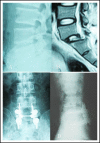Treating Traumatic Lumbosacral Spondylolisthesis Using Posterior Lumbar Interbody Fusion with three years follow up
- PMID: 25225542
- PMCID: PMC4163248
- DOI: 10.12669/pjms.305.5096
Treating Traumatic Lumbosacral Spondylolisthesis Using Posterior Lumbar Interbody Fusion with three years follow up
Abstract
Objective: To analyze the surgical outcome of traumatic lumbosacral spondylolisthesis treated using posterior lumbar interbody fusion, and help spine surgeons to determine the treatment strategy.
Methods: We reviewed retrospectively five cases of traumatic lumbosacral spondylolisthesis treated in our hospital from May 2005 to May 2010. There were four male and one female patient, treated surgically using posterior lumbar interbody fusion. The patients' data including age, neurological status, operation time, blood loss, follow-up periods, X- radiographs and fusion status were collected.
Results: All the cases were treated using posterior lumbar interbody fusion to realize decompression, reduction and fusion. Solid arthrodesis was found at the 12-month follow-up. No shift or breakage of the instrumentation was found, and all the patients were symptom-free at the last follow-up.
Conclusion: Traumatic lumbosacral spondylolisthesis can be treated using posterior lumbar interbody fusion to realize the perfect reduction, decompression, fixation and fusion.
Keywords: Follow-up; Posterior lumbar interbody fusion; Traumatic lumbosacral spondylolisthesis.
Figures
Similar articles
-
Short-term outcomes of lateral lumbar interbody fusion without decompression for the treatment of symptomatic degenerative spondylolisthesis at L4-5.Neurosurg Focus. 2018 Jan;44(1):E6. doi: 10.3171/2017.10.FOCUS17566. Neurosurg Focus. 2018. PMID: 29290128
-
[POSTERIOR LUMBAR INTERBODY FUSION FOR DOUBLE-SEGMENTAL BILATERAL ISTHMIC LUMBAR SPONDYLOLISTHESIS].Zhongguo Xiu Fu Chong Jian Wai Ke Za Zhi. 2015 Dec;29(12):1500-3. Zhongguo Xiu Fu Chong Jian Wai Ke Za Zhi. 2015. PMID: 27044218 Chinese.
-
Axial presacral lumbar interbody fusion and percutaneous posterior fixation for stabilization of lumbosacral isthmic spondylolisthesis.J Spinal Disord Tech. 2012 Apr;25(2):E36-40. doi: 10.1097/BSD.0b013e318233725e. J Spinal Disord Tech. 2012. PMID: 21964453
-
Double-level lumbar spondylolysis and spondylolisthesis: A retrospective study.J Orthop Surg Res. 2018 Mar 16;13(1):55. doi: 10.1186/s13018-018-0723-3. J Orthop Surg Res. 2018. PMID: 29548343 Free PMC article. Review.
-
Outcomes following minimally invasive lateral transpsoas interbody fusion for degenerative low grade lumbar spondylolisthesis: A systematic review.Clin Neurol Neurosurg. 2018 Apr;167:122-128. doi: 10.1016/j.clineuro.2018.02.020. Epub 2018 Feb 16. Clin Neurol Neurosurg. 2018. PMID: 29476935
Cited by
-
Lumbosacral Traumatic Spondylolisthesis L5 to S1-Classification and Surgical Management of a Difficult Presentation.Int J Spine Surg. 2024 Mar 4;18(1):32-36. doi: 10.14444/8553. Int J Spine Surg. 2024. PMID: 37903540 Free PMC article.
-
Progression of Diagnostic Imaging Findings of a Patient With Traumatic Spondylolisthesis Secondary to Unilateral Facet Fractures: A Case Report.J Chiropr Med. 2019 Jun;18(2):139-143. doi: 10.1016/j.jcm.2018.12.002. Epub 2019 Jun 26. J Chiropr Med. 2019. PMID: 31367201 Free PMC article.
-
Traumatic Lumbar Spondylolisthesis: A Systematic Review and Case Series.Global Spine J. 2019 Oct;9(7):767-782. doi: 10.1177/2192568218801882. Epub 2018 Sep 27. Global Spine J. 2019. PMID: 31552159 Free PMC article. Review.
-
Prediction of Primary Admission Total Charges Following Single-Level Lumbar Arthrodesis Utilizing Machine Learning.Global Spine J. 2025 Apr 17:21925682251336714. doi: 10.1177/21925682251336714. Online ahead of print. Global Spine J. 2025. PMID: 40243119 Free PMC article.
References
-
- Schmid R, Reinhold M, Blauth M. Lumbosacral dislocation: a review of the literature and current aspects of management. Injury. 2010;41(4):321–328. - PubMed
-
- Lim CT, Hee HT, Liu G. Traumatic spondylolisthesis of the lumbar spine: a report of three cases. J Orthop Surg (Hong Kong) 2009;17(3):361–365. - PubMed
-
- Vialle R, Charosky S, Rillardon L, Levassor N, Court C. Traumatic dislocation of the lumbosacral junction diagnosis, anatomical classification and surgical strategy. Injury. 2007;38(2):169–181. - PubMed
-
- Aihara T, Takahashi K, Yamagata M, Moriya H. Fracture-dislocation of the fifth lumbar vertebra A new classification. J Bone Joint Surg Br. 1998;80(5):840–845. - PubMed
Publication types
LinkOut - more resources
Full Text Sources

